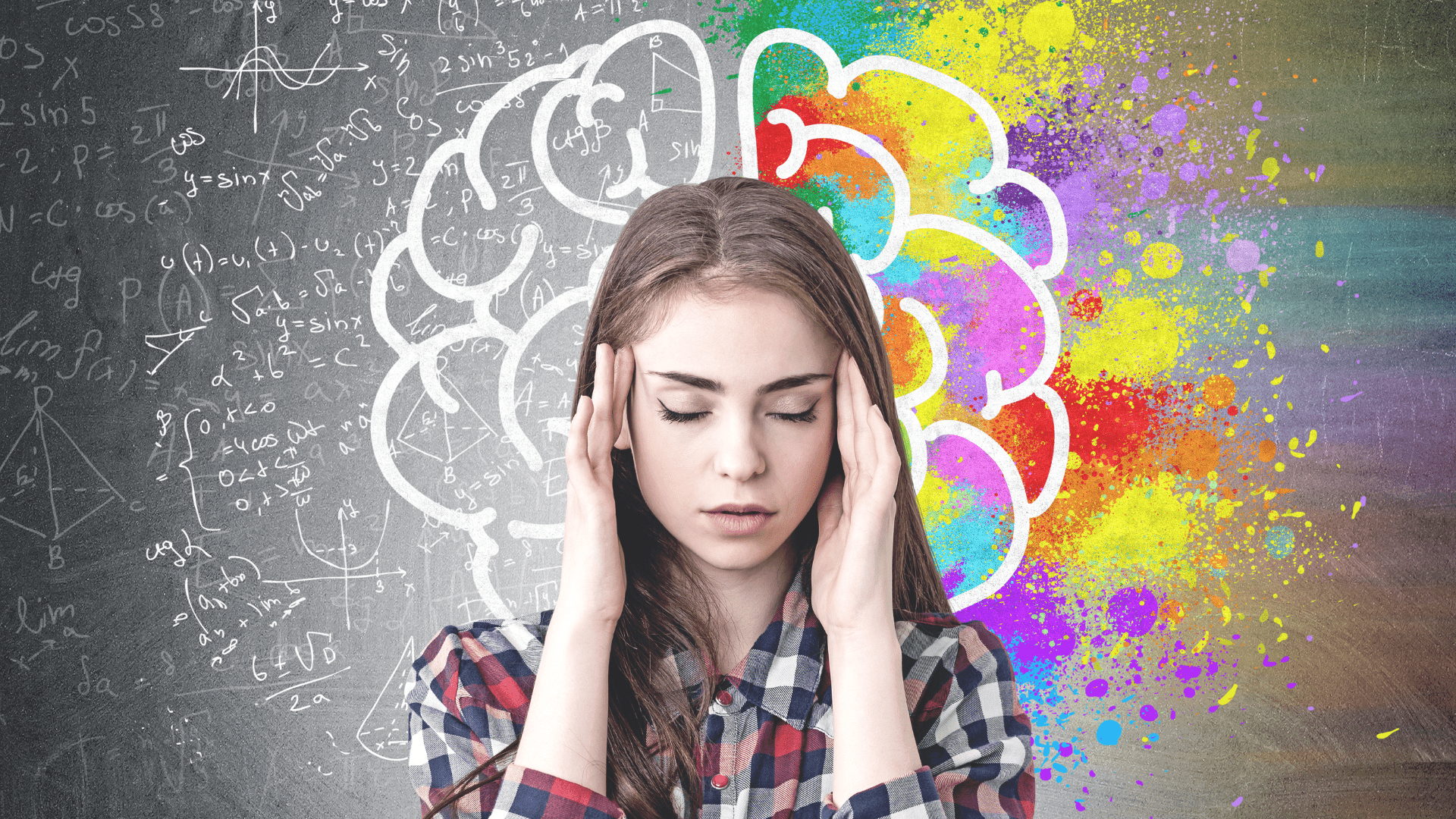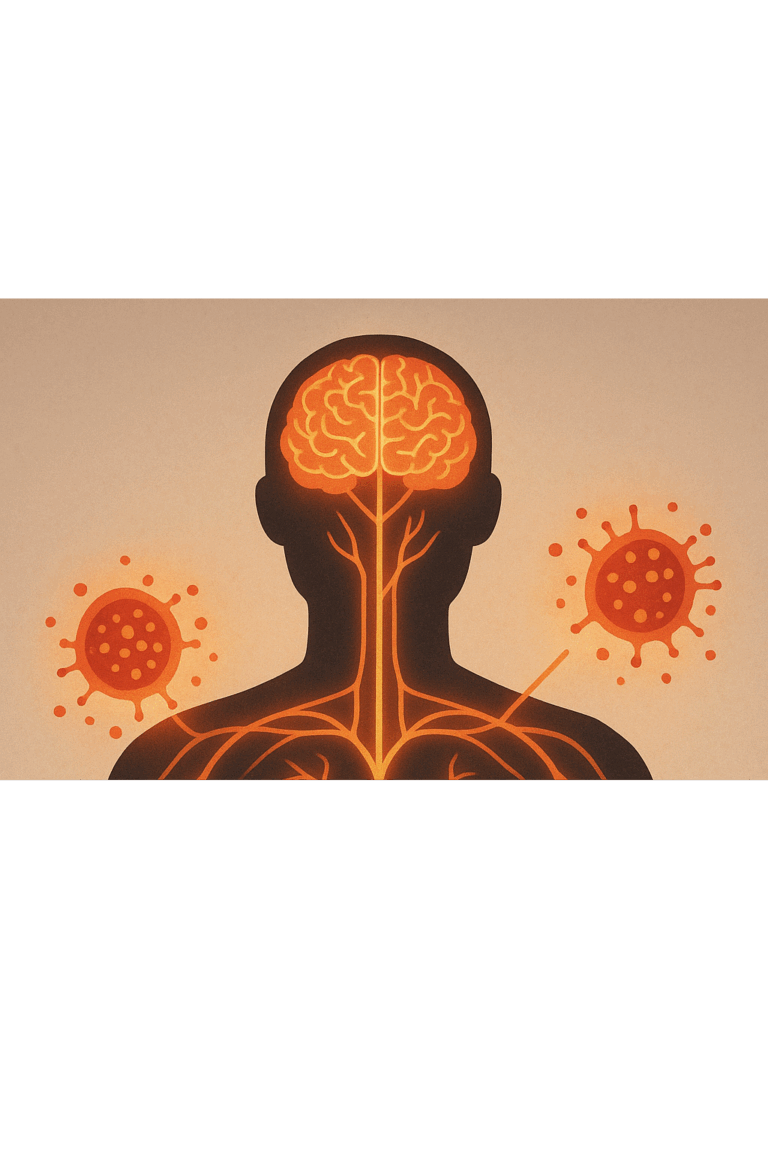- POTS and Exercise: The First Step Everyone Misses - 27 June 2025
- The Missing Link Between Breathlessness, Fatigue, and Chronic Pain: Understanding CO₂ Tolerance - 19 June 2025
- What is Mast Cell Activation Syndrome? - 12 May 2025
If you would prefer to listen to this article, please click below.
Normally, when we think of getting sick, we think of it as viruses and bacteria from the outside world getting into our bodies, however, there are occasions when this isn’t the only way that we can get sick. Let’s explore the strange question of can your brain make you ill?
It’s a well-known fact that our thoughts and emotions can affect our bodies. For example, have you ever felt a knot in your stomach when you’re nervous or stressed? Or how about getting a headache when you’re feeling overwhelmed or upset? These are just a few examples of how our mental state can impact our physical health. But it’s not just temporary symptoms that our brains can cause. Chronic stress, anxiety, and depression can lead to long-term health problems, such as heart disease, high blood pressure, and weakened immune systems. This is because the brain and body are connected by a complex network of nerves and hormones, and when the brain sends signals of stress, the body responds by releasing stress hormones that can damage our health over time.
Our brains play a crucial role in our overall health, and when things go wrong in the brain, it can lead to physical symptoms and illnesses.
This article covers:
ToggleThe Surprising Connection Between Your Brain and Physical Illness
Recent studies in the field of neuroimmunology are revealing a close relationship between our brain and our immune system, and how our mental state can affect our bodily responses to illness and disease.
Hedva Haykin, a doctoral student at the Technion — Israel Institute of Technology in Haifa, is at the forefront of this research. Her experiments, conducted on mice, show that stimulation of a brain region involved in positive emotion and motivation can influence how the heart heals after a heart attack. By triggering immune changes, the activation of the brain’s reward centre called the ventral tegmental area (VTA), reduces scar tissue and promotes healing.
Haykin is part of a growing group of scientists who are exploring the brain’s control over the body’s immune responses. Their work is inspired by decades of research pointing to the contribution of a person’s psychological state to their heart health. The phenomenon is well-known in the condition known as ‘broken-heart syndrome’, where an extremely stressful event can cause the symptoms of a heart attack. Conversely, studies have also suggested that a positive mindset can lead to better outcomes in cardiovascular disease patients.
Additionally, their work is also investigating the impact of the brain on cancer treatment. In a recent experiment, activation of neurons in the VTA reduced the size of lung and skin tumours in mice. This was because VTA activation subdued cells in the bone marrow that would usually repress immune activity, freeing the immune system to fight cancer.
Another area of research is focused on using virtual reality to manipulate people’s stress levels and see how it changes the immune response. Neuroscientist Talma Hendler is working with Tamar Koren to see if boosting the reward system in people’s brains before they receive a vaccine can improve their immune response.
While much is still a mystery, the potential applications of this research are very broad. By understanding the mind-body connections, we could tap into the power of the mind to improve health outcomes, enhance responses to vaccination, and even re-evaluate illnesses that have been dismissed as psychologically driven.
How the Brain Induces Symptoms of Sickness
We have seen how the brain and immune system are linked, but how does the brain even produce symptoms and why do we react to illness with symptoms like fever, fatigue, and loss of appetite?
Well, as it turns out, the answer lies in the connection between both the nervous system and the immune system. A small group of neurons near the base of the brain help to induce symptoms of sickness, fever, and appetite loss. These neurons, found in the hypothalamus, have receptors capable of detecting molecular signals coming from the immune system, which can then signal the brain that the body is under attack. This is pretty astounding in itself as most neurons don’t have this superpower!
The hypothalamus is a key area of the brain that controls homeostatic functions, keeping the body in a balanced and healthy state. And, it turns out, the hypothalamus is located right next to the permeable blood-brain barrier, which helps circulate blood to the brain. When the cells of the blood-brain barrier detect an infection, they release cytokines and chemokines, which activate those neurons in the hypothalamus we mentioned earlier, and they induce symptoms of sickness.
But how did researchers discover this connection between the brain and illness?
Scientists from the labs of Catherine Dulac and Xiaowei Zhuang started by examining the “fever effect” in autism patients, a phenomenon in which autism symptoms fade as a patient experiences symptoms of infection. Their goal was to find the neurons that generate fever and link them to the neurons involved in social behaviour, however, what they found was much more than they actually bargained for.
Lead researcher Jessica Osterhout found many populations of neurons that were activated when an animal was sick. She zeroed in on about 1,000 neurons in the ventral medial preoptic region of the hypothalamus because of their proximity to the blood-brain barrier, and using powerful tools like chemogenomics and optogenetics, the researchers were able to activate or silence the neurons in the brains of mice and pin down their function.
These experiments showed that the neurons described in the study project to 12 brain areas, some of which are known to control thirst, pain sensation, and social interactions. This suggests that other sickness behaviours may be affected by the neuron activity in the area. The scientists also noticed increased activity and activation in this population of neurons when molecules from the immune system gave off increased signals, suggesting that the brain and the immune system were communicating with each other.
This research has expanded our understanding of how neurons work and the critical role that paracrine signalling plays in the connection between the brain and the immune system.
Negative Thoughts on Physical Health
The connection between our mental and physical health has been a topic of interest for centuries. While we have long known that stress and negative emotions can affect our physical well-being, a growing body of evidence, suggests that even such things as negative thinking patterns can also be a cause for concern when it comes to our health. Of these thinking patterns, cynicism, hostility, and depression have all been linked to various health problems, from things like heart disease, strokes, and even type 2 diabetes.
Cynicism and hostility impact health
Both of these have been linked to a higher risk of dementia and heart disease. In a study published in Neurology, high levels of cynicism later in life were found to be associated with a greater risk of dementia than those who were more trusting. Another study published in Psychophysiology found that cynical hostility, a reaction to stressful situations with a similar intensity level no matter how much exposure one has to stress, can lead to a high risk of heart disease. Similarly, a study published in Stroke found that people who scored higher on measures of chronic stress and depressive symptoms had a higher risk of stroke.
Depression impacts health
Depression is not just a mental health condition; it also has significant effects on our physical health, impacting many bodily systems, including the central nervous system, digestive system, cardiovascular system, and even our immune system.
Long term depression can also have very far-reaching impacts on our health, and research has suggested that depression increases the risk of type 2 diabetes, heart attack, and disability later in life. Negative thoughts and emotions have been linked to changes in various bodily processes, such as metabolism, hormone release, and immune function, and some researchers even believe that increased cortisol levels, a hormone that is released when we are stressed or depressed, can make our immune systems less able to control inflammation, leading to health problems over time.
Central nervous system: Depression can cause a variety of symptoms within the central nervous system. Older adults with depression may have more difficulties with memory loss and reaction time compared with younger adults with depression. Some symptoms of depression include overwhelming sadness, a sense of emptiness or hopelessness, and difficulty concentrating, making decisions, and remembering things, and can also lead to physical reactions such as frequent episodes of crying, chronic body aches, and headaches.
Digestive system: Depression can also play a role in appetite and nutrition, as people often cope with depression by overeating or not eating at all, leading to weight gain/loss and related conditions such as type 2 diabetes, or on the other hand leading to malnutrition and digestive problems such as stomach-aches, cramps, and constipation. Maintaining a healthy diet is important for those experiencing depression, as nutrients are essential for the proper functioning of neurotransmitters.
Cardiovascular and immune systems: Depression and stress are closely related and can have a negative impact on both the cardiovascular and immune systems. Stress hormones can speed up the heart rate and tighten blood vessels, leading to heart disease over time. Depression can also increase the risk of developing cardiovascular problems, particularly in younger people and those living with mild-to-major depression. Depression and stress may also weaken the immune system, making individuals more susceptible to infections and diseases. There is evidence to suggest that there may be a relationship between inflammation and depression, although the exact connection is unclear.
In children and teenagers, depression may be more difficult to detect, as they may not be able to articulate their symptoms. Some signs of depression in children include persistent clinginess, worry, and irritability, while symptoms in teens may include poor grades, excessive use of social media or computer games, self-harm, and a negative change in behaviour at home or at school.
How Anxiety Can Make You Feel Ill
Anxiety is a complex emotion that can manifest in various forms, including physical symptoms. In fact, many individuals who do suffer from anxiety experience symptoms that feel like physical illness, such as nausea, light-headedness, fatigue, and swelling of the glands. This can be a source of concern and most often cause further anxiety, creating a somewhat vicious cycle.
Research has shown that the physical symptoms of anxiety are related to the body’s stress response. When a person experiences anxiety, the body releases a surge of hormones, including cortisol, which triggers the fight or flight response. This response prepares the body for a potential crisis, causing an increase in heart rate, breathing rate, muscle tension, and blood flow to the brain. The digestive system is also affected by stress, leading to a range of symptoms such as nausea, vomiting, heartburn, stomachache, gas, bloating, diarrhoea, constipation, and bowel spasms.
Furthermore, anxiety disorders, such as generalized anxiety disorder (GAD), panic disorder, phobias, post-traumatic stress disorder (PTSD), and social anxiety disorder, can cause physical symptoms such as nausea. People with irritable bowel syndrome (IBS) or chronic upset stomach, such as the hypermobile population that we work with, are far more likely to experience nausea and vomiting when they feel anxious. Likewise, the gut-brain axis may also play a role in anxiety-related nausea. Research has shown that the gut and brain are connected, and stress and anxiety can affect the gut microbiome and gut function. This, in turn, can result in digestive symptoms such as nausea.
Chronic Pain or Hypermobility/EDS
As you can see from the above, our brains can indeed make us ill. So, where does that leave you if you have chronic pain or hypermobility? Well, those with pain are at a much higher risk of developing the cascade of top-down symptoms we mentioned in this article. Most notably there are two things you should really keep in mind if you have Fibromyalgia or hypermobility. If you can really work on these two areas, you will help to mitigate a lot of pain and stress.
Sleep
Research shows a strong link between sleep disturbances and pain, which always leads to poor physical functioning and mood. Good sleep quality, on the other hand, can have a profound effect on mood, cognitive function, and overall health. For those with hypermobility, however, achieving good sleep can be difficult due to factors such as recurrent subluxation/dislocations during sleep, feeling “tired but wired”, and pain in general. One survey of EDS patients showed that 56% experienced difficulty maintaining sleep. Likewise, for those with Fibromyalgia, many studies highlight the high prevalence of sleep problems in the Fibromyalgia population, with many suggesting that sleep may be related to depression through pain and physical functioning. This does appear to make sense. We already know there is a strong link between emotional regulation and lack of sleep, and if your pain is stopping you from sleeping, it will affect other aspects of you. Several large prospective studies go as far as to suggest that prolonged sleep problems may even increase the risk of developing chronic pain in the future for healthy individuals. Additionally, the study of 1000 individuals found that napping was prevalent in around 85% of those with Fibromyalgia.
We always recommend our clients to really focus on their sleep health, as not doing so causes a lot of issues down the line. We wrote a comprehensive article on sleep and more importantly sleeping positions, along with a video on sleep position tips. We would really recommend you check it out. You can find it here.
Anxiety
There is more and more research now, that shows a prevalence of low Co2 levels in some sufferers of pain, fatigue, and autonomic dysfunction. We say it all the time to our clients, anxiety is a chemical reaction, and one such cause of this has gained some good research lately: Hypocapnia. When your Co2 levels drop and become chronically low (hypocapnia), it triggers your brain to activate your sympathetic nervous system (fight and flight response) and to start bringing in more air. Keep in mind, that this very much works both ways: being in pain will trigger you to bring in more air, and taking in too much air will trigger your fight or flight response.
Too much air volume effectively bottoms out your Co2 levels and tells your brain that you are in danger. You should already know by now from your time on the programme, that nociceptors detect potentially dangerous stimuli such as pressure, temperature, stretch, and chemicals and gasses like Co2. More importantly, the tolerance of these nociceptor nerves can lower over time, just like when we are in pain. This means that they become sensitised and start to react to stimuli that they shouldn’t be reacting to: think about people with fibromyalgia whose clothes start to cause pain.
When the system is switched to sympathetic mode, all non-essential systems, including rational and logical thought and chemicals that keep us calm, are turned off. When you’re in a life-or-death situation, you want to be anxious because it allows you to detect danger and threats before they become a real issue. In this situation, you don’t want to be logical; you want your brain to over-analyze and anticipate the worst possible scenario so you can be prepared. This is what anxiety is, and it’s why you may still feel anxious even though you know there is no reason to be.
Long-term sympathetic nervous system activation will cause and factor into many issues including autonomic dysfunction, anxiety, depression, lingering infections, fatigue, mast cell and histamine issues, and a whole host of other things like stagnant hypoxia.
Stagnant hypoxia (lack of oxygen) occurs when oxygen-rich blood moves too slowly to provide the required amount of oxygen. In people with POTS, sitting up causes a 30% reduction in cerebral blood flow, resulting in “stagnant” hypoxia. Although their hearts increase the cardiac output (beating faster), the blood flow to their brains decreases and chemoreceptors trigger a need to bring in more air, causing lower CO2 levels, constricting blood vessels, and reducing oxygen delivery to the brain. CO2 can resolve the problem by normalizing blood flow and stopping tachycardia.
Similarly, in ME/CFS and fibromyalgia, stagnant hypoxia may result from delivery issues, causing energy production problems and reduced aerobic capacity. Some of the research in this area suggests that the reduced cerebral blood flow found in people with ME/CFS is likely linked to energy production problems in the muscles, that result in increased blood acidity. This acidity then triggers reduced CO2 levels, which exacerbate the constricted blood flow.
So, there we have it, can our brains make us ill?
In short, yes, pretty easily!
Thanks for reading and take it easy out there.
–The Fibro Guy Team–
P.s.
We put together a short course on Co2 and how to increase your baseline tolerance to it, with the aim to force your brain into a relaxed and anxiety-free state by utilising your body’s own chemical mechanisms. Feel free to check it out in the shop on the website.






